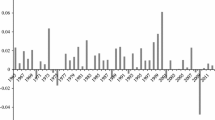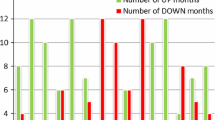Abstract
We find that momentum caused by disposition effect is mainly driven by stocks with unrealized capital gains and it is greater when price elasticity of demand is low. We further find that the size effect on momentum and January seasonality in momentum disappear when price elasticity of demand is low. In addition, the price elasticity of demand for stocks is related to the phase of business cycle and degree of product substitutability. Our findings are robust to other factors and the effect of market states on momentum profits.
Similar content being viewed by others
Notes
Other papers that explain momentum arising out of disposition effect include Hur et al. (2010).
See Page 314 in Grinblatt and Han (2005) for more detailed explanation.
Grinblatt et al. (1995) show that momentum is entirely driven by buying winners and not by selling losers.
This essentially removes all ADRs, SBIs, Units, REITS, closed-end funds and companies incorporated outside the U.S.A.
Use of T = 3 years though somewhat arbitrary recognizes the fact that longer time period are not useful as distant market prices have little effect on the reference price while it also gives us an accurate measure of unrealized capital gains (losses). Moreover Grinblatt and Han (2005) show that ability of capital gains overhang measure to predict future returns is insensitive to using 3, 5 or 7 years of past returns and volume data.
Please see Page 585 in Shleifer (1986) for more detailed explanation.
Similar to Fu (2009), the idiosyncratic volatility of stock i in month t is defined as standard deviation of the residuals from three factor model regression using daily returns times the square root of the number of trading days in the month. We include only firms that have at least 12 trading days in a month for the computation of idiosyncratic volatility. Please see Page 26 in Fu (2009) for detailed explanation.
Please see Page 318 in Grinblatt and Han (2005) for more detailed explanation.
We thank an anonymous referee for this insightful argument.
We exclude the months with negative slope coefficient of regression Eq. (3) because the increase of abnormal volume should cause the increase of abnormal return if it captures inelasticity of demand. However, our results are robust to the inclusion of those months.
We extracted the returns of the factor portfolios from Professor Kenneth French’s website. We sincerely thank Professor French for providing us with the data.
There are 492 months of liquidity factors unlike 513 for Fama–French 3 factors. After excluding 15 months of negative elasticity months, we form 477 months into 3 groups on elasticity in Panel D.
We identity the periods of recession in our sample period from NBER website as follows: December 1969–November 1970; November 1973–March 1975; January–July 1980; July 1981–November 1982; July 1990–March 1991; March 2001–November 2001; December 2007–June 2009.
References
Ahern R (2014) Do common stocks have perfect substitutes? Rev Econ Stat 98(4):756–766
Atkins A, Dyl E (1997) Transaction costs and holding periods for common stocks. J Finance 52(1):309–325
Barberis N, Shleifer A, Vishny R (1998) A model of investor sentiment. J Financ Econ 49(3):307–343
Beneish M, Whaley R (1996) An anatomy of the “S&P 500 game: the effects of changing the rules. J Finance 51(5):1909–1930
Bennett A, Sias R, Starks L (2003) Greener pastures and the impact of dynamic institutional preferences. Rev Financ Stud 16(4):1203–1238
Bhootra A, Hur J (2013) The timing of 52-week high price and momentum. J Bank Finance 37(10):3773–3782
Blouin J, Raedy J, Shackelford D (2000) The impact of capital gains taxes on stock price reactions to S&P 500 inclusion. In: NBER working paper no. 8011
Blume M, Edelen R (2001) On S&P 500 index replication strategies. In: Working paper. University of Pennsylvania
Brandt M, Brav A, Graham J, Kumar A (2010) The idiosyncratic volatility puzzle: time trend or speculative episodes? Rev Financ Stud 23(2):863–899
Chan K, Jegadeesh N, Lakonishok J (1996) Momentum strategies. J Finance 51(5):1681–1713
Chen J, Hong H (2002) Discussion of momentum and autocorrelation in stock returns. Rev Financ Stud 15(2):565–573
Cooper M, Gutierrez R, Hameed A (2004) Market states and momentum. J Finance 59(1):1345–1365
Daniel K, Hirshleifer D, Subrahmanyam A (1998) Investor psychology and security market under- and overreactions. J Finance 53(5):1839–1886
DeLong B, Summers L, Shleifer A, Waldmann R (1990) Positive feedback investment strategies and destabilizing rational speculation. J Finance 45(2):379–395
Fama E (1998) Market efficiency, long-term returns, and behavioral finance. J Financ Econ 49(3):283–306
Fama E, French K (2008) Dissecting anomalies. J Finance 63(4):1653–1678
Field M, Pagoulatos E (1997) The cyclical behavior of price elasticity of demand. South Econ J 64(1):118–129
Frazzini A (2006) The disposition effect and under-reaction to news. J Finance 61(4):2017–2046
Fu F (2009) Idiosyncratic risk and the cross-section of expected stock returns. J Financ Econ 91(1):24–37
George T, Hwang C (2004) The 52-week high and momentum investing. J Finance 59(5):2145–2176
Grinblatt M, Han B (2005) Prospect theory, mental accounting, and momentum. J Financ Econ 78(2):311–339
Grinblatt M, Titman S, Wermers R (1995) Momentum investment strategies, portfolio performance, and herding: a study of mutual fund behavior. Am Econ Rev 85(5):1088–1105
Harris L, Gurel E (1986) Price and volume effects associated with changes in the S&P 500: new evidence for the existence of price pressures. J Finance 41(4):815–830
Hong H, Stein J (1999) A unified theory of underreaction, momentum trading, and overreaction in asset markets. J Finance 54:2143–2184
Hur J, Pritamani M, Sharma V (2010) Momentum and the disposition effect: the role of individual investors. Financ Manag 39(3):1155–1176
Jegadeesh N (1990) Evidence of predictable behavior of security returns. J Finance 45(3):881–898
Jegadeesh N, Titman S (1993) Returns to buying winners and selling losers: implications for stock market efficiency. J Finance 48(1):65–91
Jiang G, Li D, Li G (2012) Capital investment and momentum strategies. Rev Quant Finance Account 39(2):165–188
Kahneman D, Tversky A (1979) Prospect theory: an analysis of decision under risk. Econometrica 47(2):263–291
Kaul A, Mehrotra V, Morck R (2000) Demand curves for stocks do slope down: new evidence from an index weights adjustment. J Finance 55(2):893–912
Lee C, Swaminathan B (2000) Price momentum and trading volume. J Finance 55(5):2017–2069
Lehmann B (1990) Fads, martingales, and market efficiency. Q J Econ 105(1):1–28
Lewellen J (2002) Momentum and autocorrelation in stock returns. Rev Financ Stud 15(2):533–563
Lo A, MacKinlay A (1990) When are contrarian profits due to stock market overreaction? Rev Financ Stud 3(2):175–205
Lynch A, Mendenhall R (1997) New evidence on stock price effects associated with changes in the S&P 500 index. J Bus 70(3):351–383
Mitchell M, Stafford E (2000) Managerial decisions and long-term stock price performance. J Bus 73(3):287–329
Newey W, West K (1987) A simple, positive semi-definite, heteroskedasticity and autocorrelation consistent covariance matrix. Econometrica 55(3):703–708
Pastor L, Stambaugh R (2004) Liquidity risk and expected stock returns. J Polit Econ 111(3):642–685
Roll R, Schwartz E, Subrahmanyam A (2011) Volume in redundant assets. In: Working paper, UCLA
Shefrin H, Statman M (1985) The disposition to sell winners too early and ride losers too long: theory and evidence. J Finance 40(3):777–790
Shleifer A (1986) Do demand curves for stocks slope down? J Finance 41(3):579–590
Thaler R (1980) Toward a positive theory of consumer choice. J Econ Behav Organ 1(1):39–60
Tversky A, Kahneman D (1974) Judgement under uncertainty: heuristics and biases. Science 185(4157):1124–1131
Wurgler J, Zhuravskaya E (2002) Does arbitrage flatten demand curves for stocks? J Bus 75(4):583–608
Yao Y (2012) Momentum, contrarian, and the January seasonality. J Bank Finance 36(10):2757–2769
Yeh C-C, Li C-A (2011) Investor psychological and behavioral bias: do high sentiment and momentum exist in the China stock market? Rev Pac Basin Financ Mark Pol 14(3):429–448
Yu S (2012) New empirical evidence on the investment success of momentum strategies based on relative stock prices. Rev Quant Finance Account 39(1):105–121
Author information
Authors and Affiliations
Corresponding author
Rights and permissions
About this article
Cite this article
Egginton, J., Hur, J. & Singh, V. The impact of elasticity on disposition effect driven momentum, substitutability, size, and January seasonality. Rev Quant Finan Acc 52, 759–780 (2019). https://doi.org/10.1007/s11156-018-0725-6
Published:
Issue Date:
DOI: https://doi.org/10.1007/s11156-018-0725-6




